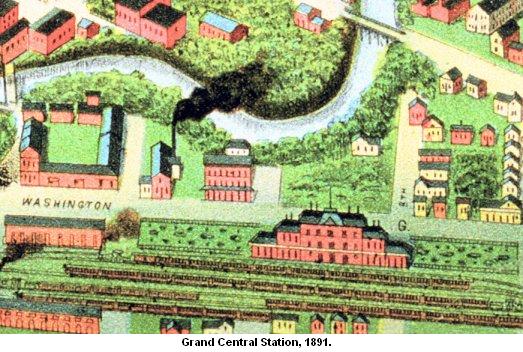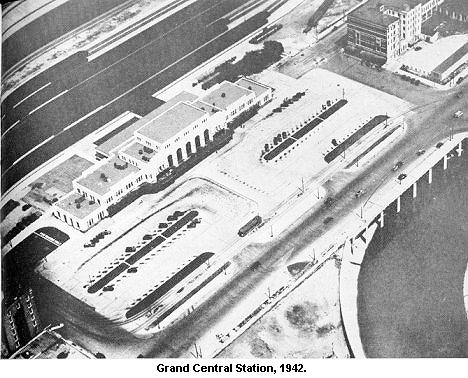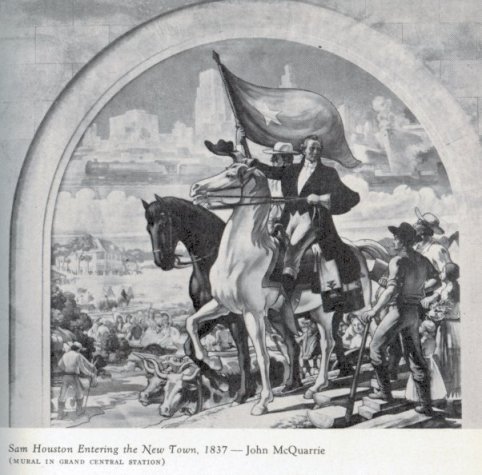In earlier times, the north bank sloped up to Washington Road where the Houston and Texas Central Railroad had its passenger depot. Near the terminal tracks, the switching yards and the parkways near the depot was Henke's Wagon Yard, a campsite established during the 1870's as an adjunct to Henry Henke's New Orleans Store. On the strip of land between Washington Road and Buffalo Bayou, opposite the site of the railroad station, was Vinegar Hill, a notorious slum where drinking, gambling and brawls were common, and cocaine addicts frequented its dives. In late October, 1886, the Texas Central Depot became the center of local interest when the fierce Apache chief Geronimo was on display at the depot while a prisoner of war of the US Army and en route from Fort Sam Houston in San Antonio to confinement in Florida with thirty-two Apache braves, their women and children.
 With the growth of the railroads
in Houston and the acquisition of the Houston and Texas Central
Railroad by the Southern Pacific Railroad in 1883, a modern, three
story brick Grand Central Station was constructed in 1887 for $80,000
to replace the earlier depot on the site. Railroads were an important
transportation link between Houston and the rest of the country. By the
1890's, hotels were built in the vicinity of the depot to accommodate
the traveling businessmen and the general public.
With the growth of the railroads
in Houston and the acquisition of the Houston and Texas Central
Railroad by the Southern Pacific Railroad in 1883, a modern, three
story brick Grand Central Station was constructed in 1887 for $80,000
to replace the earlier depot on the site. Railroads were an important
transportation link between Houston and the rest of the country. By the
1890's, hotels were built in the vicinity of the depot to accommodate
the traveling businessmen and the general public. The Grand Central Hotel was across from the depot on the southeast corner of Washington Avenue and 7th Street. The hotel Dining Hall offered ten course dinners costing fifty cents in 1899. The Lawlor Hotel was located on the southwest corner of Washington Avenue and 7th Street and was near the top of the bank of Buffalo Bayou. By 1906, the Brazos Hotel was built between Buffalo Bayou and Washington Avenue, across from Grand Central Station. It was a popularly priced hotel that catered to the traveling salesmen who arrived in Houston by passenger train. The Macatee Hotel was one block east of Grand Central Station. By 1920, the Tennison Hotel, a "railroad station hotel" serving business travelers arriving by train, was built to the west of the station. The Tennison was "popularly priced" at $2 per night.

Grand Central Station was remodeled twice, once in 1906 and, again, in 1914. By 1924, the Grand Central Depot consisted of a passenger depot in the center of the main building with railroad offices on the 2nd and 3rd floors. Other offices were located on the east wing, and the baggage room and mail offices were on the west wing. Two 600 foot long train sheds extended over the tracks on the north side of the depot to protect the passengers from the elements.
Plans were made for a new passenger depot in 1929. Construction began in May, 1933, and the new Grand Central Station opened on September 1, 1934. The project was a joint venture between the Southern Pacific Railroad and the City of Houston. The total cost of $4,347,000 for the facility and tracks as well as improvements to the city streets and the bayou was divided equally between the city and the railroad company.
The modernistic station was designed by Wyatt C. Hedrick of Houston. The exterior of the building was Texas Cordova cream-colored limestone set on a base of Texas pink granite. The main waiting room was a large, two story chamber with a floor of marble and terrazzo and walls with a marble wainscoting topped with a cream-colored marble. Wood trimmings were of black walnut. Decorative panels at each end of the main room consisted of murals by John McQuarrie of San Francisco, one depicting Stephen F. Austin and Baron de Bastrop in 1823 and the other of Sam Houston entering the town in 1837. The main waiting room was flanked by offices and a restaurant on the west wing. A smaller "colored waiting room," offices, a lunch room and the baggage room were located on the east wing.

Grand Central Station was razed in 1961. It was replaced by the new US Post Office which still occupies the site.